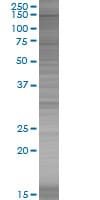SMC3 overexpression 293T lysate (whole cell) (ab94138)
Overview
-
Product name
SMC3 overexpression 293T lysate (whole cell) -
General notes
ab94138 is a 293T cell transfected lysate in which Human SMC3 has been transiently over-expressed using a pCMV-SMC3 plasmid. The lysate is provided in 1X Sample Buffer. Note: For more details about how the transfected lysate was prepared view preparation notes
-
Tested applications
Suitable for: WBmore details
Properties
-
Mycoplasma free
Yes -
Form
Liquid -
Storage instructions
Shipped on dry ice. Upon delivery aliquot and store at -20ºC. Avoid freeze / thaw cycles. -
Storage buffer
Constituents: 0.01% Bromophenol blue, 2.3% Beta mercaptoethanol, 2% Sodium lauryl sulfate, 0.788% Tris HCl, 10% Glycerol (glycerin, glycerine) -
 Concentration information loading...
Concentration information loading... -
Research areas
-
Background
Disease: Defects in SMC3 are the cause of Cornelia de Lange syndrome type 3 (CDLS3) [MIM:610759]. CDLS is a dominantly inherited multisystem developmental disorder characterized by growth and cognitive retardation, abnormalities of the upper limbs, gastroesophageal dysfunction, cardiac, ophthalmologic and genitourinary anomalies, hirsutism, and characteristic facial features. CDSL3 is a mild form with absence of major structural anomalies typically associated with CDLS. The phenotype in some instances approaches that of apparently non-syndromic mental retardation. Domain: The flexible hinge domain, which separates the large intramolecular coiled coil regions, allows the heterotypic interaction with the corresponding domain of SMC1A or SMC1B, forming a V-shaped heterodimer. The two heads of the heterodimer are then connected by different ends of the cleavable RAD21 protein, forming a ring structure. Function: Central component of cohesin, a complex required for chromosome cohesion during the cell cycle. The cohesin complex may form a large proteinaceous ring within which sister chromatids can be trapped. At anaphase, the complex is cleaved and dissociates from chromatin, allowing sister chromatids to segregate. Cohesion is coupled to DNA replication and is involved in DNA repair. The cohesin complex plays also an important role in spindle pole assembly during mitosis and in chromosomes movement. PTM: Phosphorylated upon DNA damage, probably by ATM or ATR. Acetylation at Lys-105 and Lys-106 by ESCO1 is important for genome stability and S phase sister chromatid cohesion. Regulated by DSCC1, it is required for processive DNA synthesis, coupling sister chromatid cohesion establishment during S phase to DNA replication. Similarity: Belongs to the SMC family. SMC3 subfamily.
Images
-
ab94138 at 15µg/lane on an SDS-PAGE gel.
-
All lanes : Anti-SMC3 antibody (ab89618) at 1/500 dilution
Lane 1 :SMC3 overexpression 293T lysate (whole cell) (ab94138)
Lane 2 : 293T non-transfected lysate
Lysates/proteins at 25 µg per lane.
Secondary
All lanes : Goat Anti-mouse IgG (H and L) HRP conjugated at 1/2500 dilution





